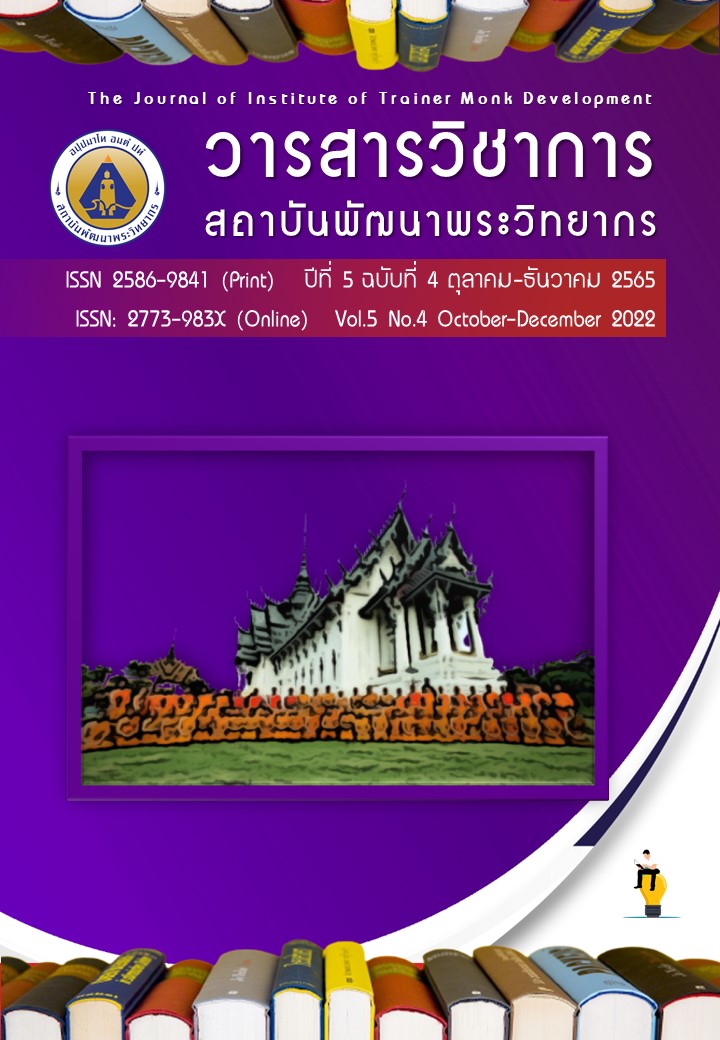The Analyzing the Pandaka as the third gender in Buddhism
Main Article Content
Abstract
Article on the analyzing the Pandaka as the third gender in Buddhism, it has two objectives: 1) the Pandaka and the third gender in Buddhismthe, 2) the analyzing the Pandaka as the third gender in Buddhism. The results showed that Pandaka in Buddhism Refers to a human being that is not a man or a woman, has a thick desire, has a strong desire unknown when being taken over by lust. There are five types of Pandaka, 1) Asit Pandaka, 2) Usuiy Pandaka, 3) Opakkamiya Pandaka, 4) Pakka Pandaka, 5) Napungsaka Pandaka. The third gender refers to a group of people of different genders or gay LGBTQ is a group of people with a gender identity or sexual orientation that is different from that of most people in society. The analyzing the Pandaka as the third gender in Buddhism as follows: 1) homosexual group The homosexual group consists of Asit Pandaka socializing with gay, Pakka Pandaka socializing with gay queen 2) Usui Pandaka socializing with unnatural 3) The group has no sex symbol consists of Opakkmiya Pandaka and Napungsoka Pandaka. What is interesting is Pandaka that (1) Asit Pandaka and Type (2) Usuya Pandaka that can be ordained as for the type (4) Pakkha Pandaka can be ordained on a no lust day. As for the type of Pandaka that cannot be ordained, the types (3) and (5) are those who are castrated or have a gender dysphoria.
Article Details

This work is licensed under a Creative Commons Attribution-NonCommercial-NoDerivatives 4.0 International License.
บทความที่ได้รับการตีพิมพ์เป็นลิขสิทธิ์ของวารสารวิชาการสถาบันพัฒนาพระวิทยากร
ข้อความที่ปรากฎอยู่ในบทความที่ได้รับการตีพิมพ์ในวารสาร ถือเป็นความรับผิดชอบของผู้เขียนบทความ และข้อคิดเห็นนั้นไม่ถือว่าเป็นทัศนะและความรับผิดชอบของกองบรรณาธิการวารสารวิชาการสถาบันพัฒนาพระวิทยากร
References
กฤตยา อาชวนิจกุล. (2554). เพศวิถีศึกษากับเพศวิถีปฏิบัติในสังคมไทย. กรุงเทพมหานคร: โรงพิมพ์เดือนตุลา.
ชัญวลี ศรีสุโข. (2552). “ศุกร์กับเซ็กส์-กะเทยแท้-กะเทยเทียม”. คมชัดลึก. สืบค้นเมื่อวันที่ 1 มิถุนายน 2564 จาก https://www.komchadluek.net/news/lifestyle/28857.
ทองย้อย แสงสินชัย. (2564). บาลีวันละคำ (1,171) ลักเพศ. สืบค้นเมื่อวันที่ 1 กรกฎาคม 2564, จาก https://www.facebook.com/tsangsinchai/posts/915606918533046.
ปิยวรรณ วิเศษสุวรรณภูมิ และคณะ. (2565) วัยรุ่นที่มีความหลากหลายทางเพศ: การดูแลช่วยเหลืออย่างเข้าใจ. วารสารเทคโนโลยีสุรนารี. ปีที่ 16 ฉบับที่ 2 (กรกฎาคม-ธันวาคม).
ราชบัณฑิตยสถาน. (2554). พจนานุกรมฉบับราชบัณฑิตยสถาน 2554. สืบค้นเมื่อวันที่ 1 กรกฎาคม 2564 จาก https://dictionary.orst.go.th.
พระมหาสักชาย กนฺตสีโล. (2551). “การศึกษาวิเคราะห์เรื่องบัณเฑาะก์ ในกลุ่มพระภิกษุสามเณรไทย ในปัจจุบัน”. วิทยานิพนธ์ศิลปศาสตรมหาบัณฑิต. บัณฑิตวิทยาลัยมหาวิทยาลัยธรรมศาสตร์.
มหาวิทยาลัยมหาจุฬาลงกรณราชวิทยาลัย. (2539). พระไตรปิฎกฉบับภาษาไทย ฉบับมหาจุฬาลงกรณราชวิทยาลัย. กรุงเทพมหานคร: โรงพิมพ์มหาจุฬาลงกรณราชวิทยาลัย.
วิกิพีเดีย. (2564). สารานุกรมเสรี. สืบค้นเมื่อวันที่ 1 กรกฎาคม 2564 จาก https://th.wikipedia.org/wiki/ขันที.
วิจารณ์ พานิช. (2524). "กะเทยก็เป็นกรรมพันธุ์ (ตอนที่ 1)" ในคอลัมน์ พันธุ์ดี. พันธุ์ศาสตร์ในชีวิตประจำวัน. หมอชาวบ้าน. สืบค้นเมื่อวันที่ 1 มิถุนายน 2564 จาก https://www.doctor.or.th/article/detail/6941.
สมภพ เรืองตระกูล. (2561). ความผิดปกติทางเพศ. กรุงเทพมหานคร: เรือนแก้วการพิมพ์.
สุวัทนา อารีพรรค. (2564). กะเทยลักเพศและรักร่วมเพศ. สืบค้นเมื่อวันที่ 1 กรกฎาคม 2564 จาก แหล่งที่มา: https://www.doctor.or.th/article/detail/5237.


